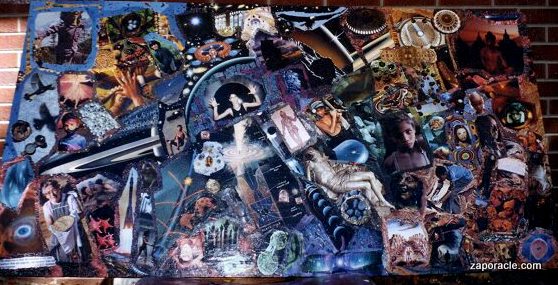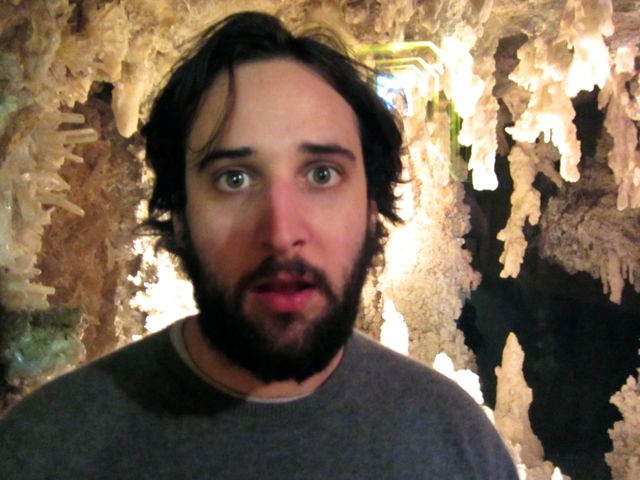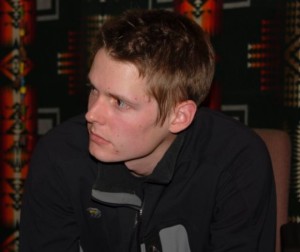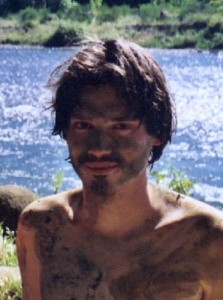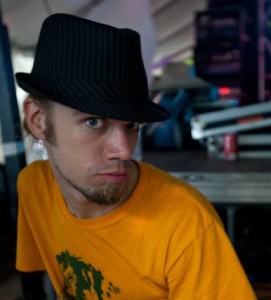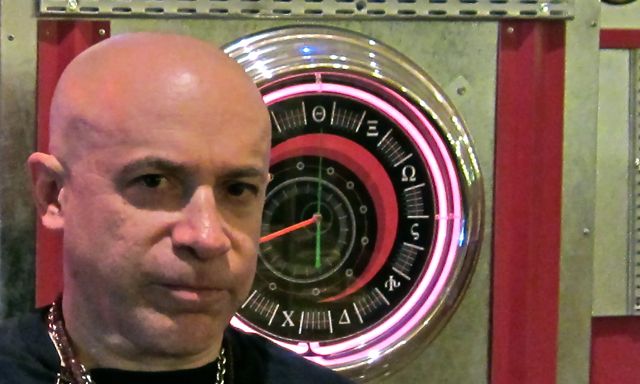text and collage © Jonathan Zap, 2011
Edited by Austin Iredale
With both misgivings and excitement I followed Adrian into the cave, our headlamps casting dense shadows amidst the illuminated surfaces of jagged rock. Adrian’s fantastic tale of an antique bronze ship of some sort secreted in an antechamber of this still largely unexplored cavern was impossible to resist, but also filled me with doubts and fears. Could it be that Adrian’s quirky and quicksilver personality had tipped over some edge and twisted to where he might be luring me to a claustrophobic, Cask of Amontillado fate?
It had been twenty years since my last and only other spelunking adventure, at which time I was a young man in peak condition, ready for any physical adventure. But, now, the cautiousness of middle age was tripping warning bells as I followed the youthful Adrian, crawling on my belly through a descending corkscrew deep into the bowels of the earth. There must be some broader, easier way to the antechamber, or how else could a metallic ship of sizable proportions have gotten down there? This was one of many questions my guide seemed too insistent and preoccupied to entertain at length. “Seeing is believing,” is all he could be bothered to say. Then he would pause long enough to flash his snaggle-toothed grin, before continuing down again. His manner suggested extreme, but benign, enthusiasm rather than anything twisted or sinister that would truly alarm my Cask of Amontillado apprehensions. At worst my guide was a case of benevolent delusion, but that was danger enough added to the hazards of our risky descent.
Such dissonant thoughts revolved in my mind for an interminable hour or so, until suddenly the corkscrew released us into the antechamber. Probing its depths with my headlamped gaze, I saw that amidst stalagmites and stalactites the color of tooth enamel, and small brown bats, hanging like fuzzy Christmas ornaments from the vaulted ceiling, stood the smooth-hulled, bronze-colored craft exactly as promised. Seeing was indeed believing. The craft exuded a feeling of extreme antiquity, while appearing to be, on the outside at least, perfectly preserved and intact.
The hull was capsule-shaped, as if it had been designed to pass through the very intestines of the earth. Here and there were a few streamlined protrusions, their functionality unclear to me. Unmistakable, though, was the ship’s small circular hatch, whose locking mechanism was not unlike that of a submarine. Adrian had told me of a hatch, and assured me that he had turned it only a quarter of a revolution, to see if it was rusted or locked, and then returned it to its original position. He wanted that I should accompany him before turning this bronze wheel its full way round.
For a few awed minutes I circled the craft, which was not over large, perhaps eighteen feet long and barely seven feet across. I touched some of the strange, streamlined protuberances with my fingertips and found that the metal was both smooth but also subtly textured in an almost organic way. When I looked closely I saw that the metal was patterned with intricate curvilinear striations that sometimes resembled the dense labyrinthine swirls of fingertips, and elsewhere the tight contour lines of old topographical survey maps. The intricate patterning of the metal did not appear to be merely on the surface, but seemed like it ran all the way through the hull, like the grain of wood or the smoky swirls of Damascus steel. I had seen such weirdly organic patterning in metal once before, many years prior. In that time, an eccentric astronomer friend of mine had placed in my hand an iron-nickel meteorite, which he had sphericalized and polished. As the meteoric sphere rested in my palm, it held the weight of a small planet, and the touch of the dense metal seemed to communicate the memory of a journey across light years of galactic space. This metal, too, though bronze-colored rather than iron-nickel grey, had a feeling of geologic antiquity, density and hidden memories. Although perfectly intact, the hull felt like it had weathered many long and strange journeys.
By silent accord, Adrian and I, after each of us had slowly circumnavigated the craft, came to a halt before the circular hatch. The silence in the cave was so unmoving that neither of us dared to breech it with words. I motioned toward the hatch, indicating that Adrian should proceed. It was his discovery, the honor of unlocking the hatch belonged to him. Adrian slowly turned the large circular latch, and after a full revolution there was a sound of precision bolts retracting like the door of a bank vault. Adrian pulled the hatch open and a breath of air was released from the slightly pressurized interior. Although I had always heard that long-enclosed air smelled foul, this air was not unpleasant and smelled strongly of cedar wood.
We stepped through the threshold, and as we did we could see the blinking on of what appeared to be small status lights, which flickered and then began to glow amber and red like rows of cabochon jewels. At the bow of the craft’s interior were two swivel chairs that appeared to be finely made of polished mahogany and upholstered in a wine-dark material like fine velvet, but which had, unaccountably, not deteriorated with age.We each took a seat and marveled that every cushioned contour seemed to have been tailored for us. Screens of thick crystal supported on metal piping began to flicker on around us. A series of gold bezeled analog instruments flickered into backlit illumination. There were what appeared to be alchemical symbols or glyphs interspersed with Roman numerals on a series of clock-like displays, where pointers and hands moved and trembled. And now we could hear the distinct sound of steam and of valves opening and closing beneath our feet. The craft was obviously powering up, and as the hissing of steam grew louder, the crystal screens began to glow with an amber blurriness which resolved itself into streams of glyphs or symbols. As I looked closer I felt myself become mesmerized in a literal, neurological sense, as the flow of information passed through my perceptual boundaries and entered directly into my mind, uploading me with words and images that cascaded into attention and expanded concentrically just outside my ability to recognize any particular form.
I blinked, or awakened, a sudden sensation of missing time, and a feeling that just under the surface of my mind there was a swirling density of new content. The encompassing images seemed to withdraw back into the amber blur and then the screens resolved into a three-dimensional star field, so that it seemed like we faced into the dome of a planetarium. I saw some things on the dashboard I hadn’t seen before. One of the instruments, which was labeled “beacon,” had a lens or crystal and behind it a beveled rectilinear block of optical glass. On top of this glass block was a pyramidal natural crystal. Within the glass was an infinitely detailed holographic image of a DNA double helix, which looked like it was rotating along its vertical axis. When I looked closer I saw that the rotation was an illusion; it appeared to be moving because the intricately twisted filaments of which it was comprised were glowing in an ever-changing spectrum of molten color.
I was startled then by the sound of another valve opening, followed by that of a pneumatic cylinder being discharged through tubing. Then an aperture, like the diaphragm of a lens, opened on one of the control panels and a small bronze capsule, the length of a hen’s egg, popped out and arced gracefully in the air. I reached out and caught in it my hand. Adrian and I gazed as the capsule reflected the beams of our headlamps. It looked to be an exact miniature replica of the larger craft in which we were ensconced. It had precisely the same streamlined and curvilinear protuberances, and the metal had the same curvilinear striations, but, because of its downscaled replica size, they were even more intricate. There was also a replica of the hatch, but with a strange difference. At the center of the circular latch was a rectangular aperture. I looked at it closely, blinking several times to make sure my eyes, squinting in the reflected glare of the headlamps, were not deceiving me. The aperture was of the exact dimensions and appearance of a standard USB port.
With this small bronze replica harbored in my fist, its strange aperture tantalizing my curiosity, Adrian and I returned to the darkness and wound our way back up the dizzying corkscrew to rejoin the world of man. A few hours later, we were drinking spiced rum in my library as we studied the bronze capsule under a desktop magnifying lamp.
The next step seemed inevitable, and as if reading my mind, Adrian nodded in assent. I attempted to plug a USB cable into the capsule’s aperture, and found, as I had suspected, that it snapped perfectly into place. I plugged the other end of the cord into my Macbook Pro. Nothing happened. We stood dumbly in front of the unchanged screen of the Macbook.
“Maybe it’s doing something we can’t see,” suggested Adrian.
“Possibly,” I replied in a neutral tone, not wanting to arouse unfounded hopes. “Meanwhile, I’m exhausted, I suggest we sleep on it. It’s just after 3AM and I’ve been awake for almost twenty-four hours.”
I made up a bed for Adrian on the living room sofa, and then I fell into my own bed, collapsing into a deep, enveloping sleep. When I awoke the next morning, golden high desert sunlight was streaking through the window blinds, and, if it weren’t for some scrapes and sore muscles, the memory of the claustrophobic corkscrew journey to the antechamber might have seemed like it was an evaporating dream. I drowsily poured water into my tea kettle and went through the muscle memory steps necessary to make the morning’s yerba mate. Next I went to my desk and dusted my finger across the trackpad of my Macbook. The screen blinked awake, and open in the browser was a website, large metallic and machine-like font floating in a star field…
At least that’s the story of how I wish the site were created. The actual origins are only slightly less strange, but far more labor intensive. Thousands upon thousands of man-hours have been contributed by the content supplier (Jonathan Zap) and a small group of devoted, and mostly unremunerated, language and code wizards. You can read some of the actual back story (or listen to a podcast of it) here:
The Path of the Numinous–Living and Working with the Creative Muse
Oh, and not to put to fine a point on it, but thousands of dollars have been invested in this site and so far donations have totaled a sum in the hundreds of dollars. So if you have any ability to redress that imbalance, your help will be gratefully appreciated.
Here is our staff in alphabetical order (by last name):
Tanner Dery is a software engineer and expert on Word Press sites with a degree in computer game design from Brown College. If you need a state-of-the-art website this is the man to go to. Tanner has an astounding work ethic and brings creative, amazing, workaholic devotion to everything he does. He creates in days or weeks what takes others months or years if they could do it at all. Despite the impossible hours he works, I have never heard him sound stressed or impatient. He has taken my extremely eccentric sense of visual style and steam punk obsessions and run with them. Although I anticipated rebellion from my visual perfectionism and endless desire to tweak, Tanner has responded to my endless texts, phone calls and emails with enthusiasm and found ways to build the things that I could only describe.
Need a website? Check him out at tannerd.com.
Austin Iredale is a writer, editor, and actor. He has a B.A. in English Literature from Colorado University and graduated from the Stella Adler Academy of Acting and Theatre in L.A. Austin brings meticulous attention to detail to his writing and editing. One of the things that a superb editor like Austin seems to do is to catch all those areas of sloppy, undifferentiated word tissue that get missed in the lazy intoxication of rough draft generation, the beer goggles of creative exuberance which blind you to the sagging flesh of distended sentences. .Rather than imposing his own notions, Austin helps to amplify, clarify and polish every document he edits. A pleasure to work with, Austin is helping to make me a better writer.
See his website: austiniredale.com
Mathael Robintree is a software engineer and code wizard. He has a degree in computer science from the University of Oregon. He is everything you would expect from someone born with the name “Mathael.” He seems like a cross between a Vulcan, a Zen Monk and the first man to gain access to the source code of the matrix. Mathael is the code wizard of the oracle and created amazing graphics programs to allow me to tweak the look of the oracle. He took my verbal descriptions of how I wanted Theme Tracker to work and brought together the high-powered math and code to make it happen.
Drew Stricker is a talented computer graphics artist, DJ and VJ. Drew was the webmaster and designer of the site for six years—from its inception in 2004 untill his retirement in late 2010. Some of his computer graphic designs are featured in Zap Oracle cards.
Jonathan Zap is the content provider of the site. A bit more about him in the About Section.
Our Mission Statement
To provide users of the site with the finest products of our imagination, creativity and insight so as to entertain, inform and aid them in their psychological and spiritual development. To especially support “mutants” (persons with a commitment to consciousness who are working toward individual and collective metamorphosis rather than perpetuating the oppressions of the patriarchal era, which we will sometimes refer to as “the Babylon Matrix.”) To mix serious content with the surreal and humorous, so as to minimize the human tendency to form fundamentalisms, absolutisms and other cognitive rigidities. To leave it to the user to discern via their own truth sense and critical judgment what, if anything offered here, is worthy of becoming part of their philosophy of life. To be open to feedback of any kind, including dissenting points of view from users of the site. To provide as much content as possible on a donation basis so that finances do not stand in the way of anyone wanting to access what we are offering.
“The speaker has no value whatsoever, nor what he says. What has value is how you understand yourself in listening to what he says. He is like a mirror, in which you see yourself reflected. Your consciousness, your daily activity, your unconscious demands, pursuits and fears are exposed. When you so listen, then you begin to discover for yourself not the ideas, the conclusions, the assertions of the speaker, but rather you see for yourself what is true and what is false.” —Krishnamurti
See A Glossary of Zap Terms for definitions of some of the eccentric terms used on this site such as “Babylon Matrix,” “mutant,” “singularity archetype,” etc.
 ZapOracle.com home to the free 720-card Zap Oracle
ZapOracle.com home to the free 720-card Zap Oracle

